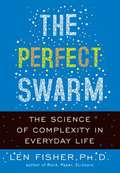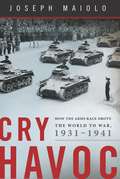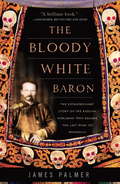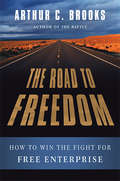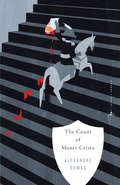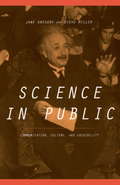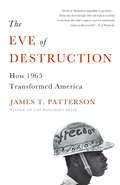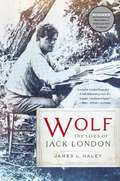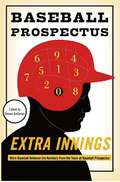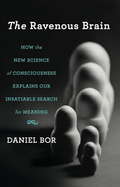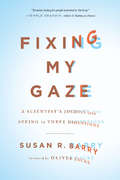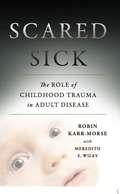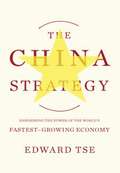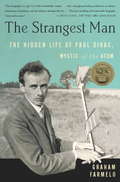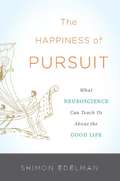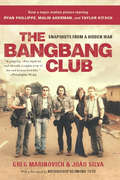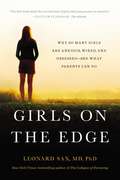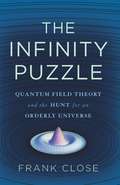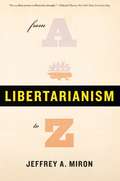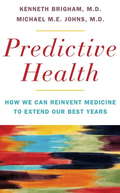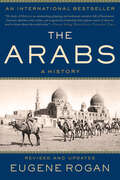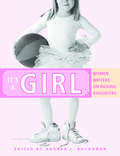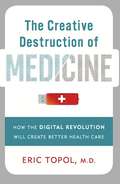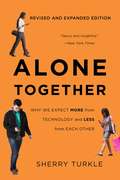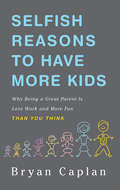- Table View
- List View
The Perfect Swarm: The Science of Complexity in Everyday Life
by Len FisherOne of the greatest discoveries of recent times is that the complex patterns we find in life are often produced when all of the individuals in a group follow the same simple rule. This process of "self-organization” reveals itself in the inanimate worlds of crystals and seashells, but as Len Fisher shows, it is also evident in living organisms, from fish to ants to human beings. The coordinated movements of fish in shoals, for example, arise from the simple rule: "Follow the fish in front. ” Traffic flow arises from simple rules: "Keep your distance” and "Keep to the right. ” Now, in his new book, Fisher shows how we can manage our complex social lives in an ever more chaotic world. His investigation encompasses topics ranging from "swarm intelligence” to the science of parties and the best ways to start a fad. Finally, Fisher sheds light on the beauty and utility of complexity theory. An entertaining journey into the science of everyday life, The Perfect Swarm will delight anyone who wants to understand the complex situations in which we so often find ourselves.
Cry Havoc: How the Arms Race Drove the World to War, 1931-1941
by Joe MaioloDid the arms race of the 1930s cause the Second World War? In Cry Havoc, historian Joseph Maiolo shows, in rich and fascinating detail, how the deadly game of the arms race was played out in the decade prior to the outbreak of the Second World War. In this exhaustively researched account, he explores how nations reacted to the moves of their rivals, revealing the thinking of those making the key decisions--Hitler, Mussolini, Chamberlain, Stalin, Roosevelt--and the dilemmas of democratic leaders who seemed to be faced with a choice between defending their nations and preserving their democratic way of life. An unparalleled account of an era of extreme political tension, Cry Havoc shows how the interwar arms race shaped the outcome of World War II before the shooting even began.
The Bloody White Baron: The Extraordinary Story of the Russian Nobleman Who Became the Last Khan of Mongolia
by PalmerPalmer introduces readers to a little known, and very bizarre, episode of post-Revolutionary Russia and to its main actor, the anti-Semitic and genocidal Baron Ungern-Sternberg. One of the leaders of the anti-Bolshevik forces in Siberia, Ungern-Sternberg and his army were pushed by the Bolsheviks into Mongolia, which had recently broken free from China. Conquering the country with cavalry--the last person in history to do such a thing--Ungern-Sternberg established a medieval-style dictatorship, murdering Jews and political opponents in a pogrom that foretold later atrocities by the Nazis. Writing in a popular style, Palmer vividly conveys the details of Ungern-Sternberg's rise to power and his eventual dispatch at the hands of victorious Soviet forces. This is a paperback reprint of a book published in cloth in 2009. Annotation ©2011 Book News, Inc. , Portland, OR (booknews. com)
The Road to Freedom: How to Win the Fight for Free Enterprise
by Arthur C. BrooksEntrepreneurship, personal responsibility, and upward mobility: These traditions are at the heart of the free enterprise system, and have long been central to America's exceptional culture. <P><P>In recent years, however, policymakers have dramatically weakened these traditions--by exploding the size of government, propping up their corporate cronies, and trying to reorient our system from rewarding merit to redistributing wealth. In The Road to Freedom, American Enterprise Institute President Arthur C. Brooks shows that this trend cannot be reversed through materialistic appeals about the economic efficiency of capitalism. Rather, free enterprise requires a moral defense rooted in the ideals of earned success, equality of opportunity, charity, and basic fairness. Brooks builds this defense and demonstrates how it is central to understanding the major policy issues facing America today. The future of the free enterprise system has become a central issue in our national debate, and Brooks offers a practical manual for defending it over the coming years. Both a moral manifesto and a prescription for concrete policy changes, The Road to Freedom will help Americans in all walks of life translate the philosophy of free enterprise into action, to restore both our nation's greatness and our own well-being in the process.
The Count of Monte Cristo: The Count Of Monte Cristo; Volume 3 (Modern Library Classics)
by Alexandre DumasIntroduction by Lorenzo Carcaterra • Nominated as one of America&’s best-loved novels by PBS&’s The Great American Read A popular bestseller since its publication in 1844, The Count of Monte Cristo is one of the great page-turning thrillers of all time. Set against the tumultuous years of the post-Napoleonic era, Alexandre Dumas&’s grand historical romance recounts the swashbuckling adventures of Edmond Dantès, a dashing young sailor falsely accused of treason. The story of his long imprisonment, dramatic escape, and carefully wrought revenge offers up a vision of France that has become immortal. As Robert Louis Stevenson declared, &“I do not believe there is another volume extant where you can breathe the same unmingled atmosphere of romance.&”
Science In Public: Communication, Culture, And Credibility
by Jane Gregory Steven MillerDoes the general public need to understand science? And if so, is it scientists' responsibility to communicate? Critics have argued that, despite the huge strides made in technology, we live in a "scientifically illiterate" society--one that thinks about the world and makes important decisions without taking scientific knowledge into account. But is the solution to this "illiteracy" to deluge the layman with scientific information? Or does science news need to be focused around specific issues and organized into stories that are meaningful and relevant to people's lives? In this unprecedented, comprehensive look at a new field, Jane Gregory and Steve Miller point the way to a more effective public understanding of science in the years ahead.
The Eve of Destruction: How 1965 Transformed America
by James T. PattersonOf all the changes that have swept across America in the past century, perhaps none have been as swift or dramatic as those that transpired in the 1960s. The United States entered the decade still flush with postwar triumphalism, but left it profoundly changed: shaken by a disastrous foreign war and unhinged by domestic social revolutions and countercultural movements that would define the nation''s character, politics, and policies for decades to come. The prevailing understanding of the 1960s traces its powerful shockwaves to 1968, a year of violent protests and tragic assassinations. But in The First Year of the Sixties, esteemed historian James T. Patterson shows that it was actually in 1965 that America truly turned a corner and entered the new, tumultuous era we now know as "The Sixties. " In the early 1960s, America seemed on the cusp of a golden age. Political liberalism, national prosperity, and interracial civil rights activism promised positive change for many Americans. Although the nation had been shocked by the 1962 Cuban Missile Crisis and the 1963 assassination of President Kennedy, America''s fundamental traditions and mores remained intact. It was a time of consensus and optimism, and popular culture reflected this continuity. Young people dressed and behaved almost exactly as they did in the 1950s, and if the music and hairstyles of the British Invasion worried some conservative parents, these concerns were muted. At the beginning of 1965, Americans saw no indication that the new year would be any different. In January, President Johnson proclaimed that the country had "no irreconcilable conflicts. " Initially, events seemed to prove him right. The economy continued to boom, and the overwhelmingly Democratic Congress passed a host of historic liberal legislation, from the Voting Rights Act to Medicare and Medicaid to expansions of federal aid for education and the war on poverty. But Patterson shows that, even amidst these reassuring developments, American unity was unraveling. Turmoil erupted in the American South and overseas in the spring of 1965, with state troopers attacking civil rights demonstrators in Selma, Alabama and American combat troops rushing into Vietnam to protect American interests there. Many black leaders, meanwhile, were becoming disenchanted with nonviolence, and began advocating instead for African-American militancy. That summer, as anti-war protests reached a fever pitch, rioting exploded in the Watts area of Los Angeles; the six days of looting and fires that followed shocked many Americans and cooled their enthusiasm for the president''s civil rights initiatives, which--like his other "Great Society" programs--were also being steadily undermined by the costly and unpopular war in Vietnam. Conservative counterattacks followed, with Republicans like California gubernatorial candidate Ronald Reagan--and even some disillusioned Democrats--criticizing the President for mismanaging the war and expanding the federal government past its manageable limits. As Patterson explains, this growing pessimism permeated every level of society. By the end of 1965 the national mood itself had darkened, as reflected in a new strain of anti-establishment rock music by artists like the Rolling Stones, Bob Dylan, the Grateful Dead, and Jefferson Airplane. Their songs and lyrics differed dramatically from the much more staid recordings of contemporary acts like Frank Sinatra, Julie Andrews, and the Supremes, reflecting an alienation from mainstream American culture shared by an increasing number of young Americans. In The First Year of the Sixties, James T. Patterson traces the transformative events of this critical year, showing how 1965 saw an idealistic and upbeat nation derailed by developments both at home and abroad. An entire generation of Americans--as well as the country''s politics, culture, race relations, and foreign policies--would never be the same.
Wolf: The Lives of Jack London
by James L. HaleyAward-winning western historian James L. Haley paints a vivid portrait of Jack London?adventurer, social reformer, and the most popular American writer of his generation
Extra Innings: More Baseball Between the Numbers from the Team at Baseball Prospectus
by Steven Goldman The Baseball ProspectusIn 1996, a brassy young team of fans produced a guide to baseball statistics. Printed on a photocopier, its distribution, which was in the low hundreds, was limited to friends, family, and die-hard stat heads. Sixteen years later, the Baseball Prospectus annual regularly hits best-seller lists and has become an indispensable guide for the serious fan. In Extra Innings, the team at Baseball Prospectus integrates statistics, interviews, and analysis to deliver twenty arguments about today's game. In the tradition of their seminal book, Baseball Between the Numbers, they take on everything from steroids to the amateur draft. They probe the impact of managers on the game. They explain the critical art of building a bullpen. In an era when statistics matter more than ever, Extra Innings is an essential volume for every baseball fan.
The Ravenous Brain: How the New Science of Consciousness Explains Our Insatiable Search for Meaning
by Daniel BorConsciousness is our gateway to experience: it enables us to recognize Van Gogh's starry skies, be enraptured by Beethoven's Fifth, and stand in awe of a snowcapped mountain. Yet consciousness is subjective, personal, and famously difficult to examine: philosophers have for centuries declared this mental entity so mysterious as to be impenetrable to science. In The Ravenous Brain, neuroscientist Daniel Bor departs sharply from this historical view, and builds on the latest research to propose a new model for how consciousness works. Bor argues that this brain-based faculty evolved as an accelerated knowledge gathering tool. Consciousness is effectively an idea factory--that choice mental space dedicated to innovation, a key component of which is the discovery of deep structures within the contents of our awareness. This model explains our brains' ravenous appetite for information--and in particular, its constant search for patterns. Why, for instance, after all our physical needs have been met, do we recreationally solve crossword or Sudoku puzzles? Such behavior may appear biologically wasteful, but, according to Bor, this search for structure can yield immense evolutionary benefits--it led our ancestors to discover fire and farming, pushed modern society to forge ahead in science and technology, and guides each one of us to understand and control the world around us. But the sheer innovative power of human consciousness carries with it the heavy cost of mental fragility. Bor discusses the medical implications of his theory of consciousness, and what it means for the origins and treatment of psychiatric ailments, including attention-deficit disorder, schizophrenia, manic depression, and autism. All mental illnesses, he argues, can be reformulated as disorders of consciousness--a perspective that opens up new avenues of treatment for alleviating mental suffering. A controversial view of consciousness, The Ravenous Brain links cognition to creativity in an ingenious solution to one of science's biggest mysteries.
Fixing My Gaze $ A Scientist's Journey Into Seeing in Three Dimensions: A Scientist's Journey Into Seeing in Three Dimensions
by Susan R. BarryWhen neuroscientist Susan Barry was fifty years old, she took an unforgettable trip to Manhattan. As she emerged from the dim light of the subway into the sunshine, she saw a view of the city that she had witnessed many times in the past but now saw in an astonishingly new way. Skyscrapers on street corners appeared to loom out toward her like the bows of giant ships. Tree branches projected upward and outward, enclosing and commanding palpable volumes of space. Leaves created intricate mosaics in 3D. With each glance, she experienced the deliriously novel sense of immersion in a three dimensional world. Barry had been cross-eyed and stereoblind since early infancy. After half a century of perceiving her surroundings as flat and compressed, on that day she was seeing Manhattan in stereo depth for first time in her life. As a neuroscientist, she understood just how extraordinary this transformation was, not only for herself but for the scientific understanding of the human brain. Scientists have long believed that the brain is malleable only during a “critical period” in early childhood. According to this theory, Barry’s brain had organized itself when she was a baby to avoid double vision – and there was no way to rewire it as an adult. But Barry found an optometrist who prescribed a little-known program of vision therapy; after intensive training, Barry was ultimately able to accomplish what other scientists and even she herself had once considered impossible. A revelatory account of the brain’s capacity for change, Fixing My Gaze describes Barry’s remarkable journey and celebrates the joyous pleasure of our senses.
Scared Sick: The Role of Childhood Trauma in Adult Disease
by Robin Karr-Morse Meredith S. WileyThe first years of human life are more important than we ever realized. InScared Sick, Robin Karr-Morse connects psychology, neurobiology, endocrinology, immunology, and genetics to demonstrate how chronic fear in infancy and early childhood- when we are most helpless-lies at the root of common diseases in adulthood. Compassionate and based on the latest research,Scared Sickwill unveil a major public health crisis. Highlighting case studies and cutting-edge scientific findings, Karr- Morse shows how our innate fight-or-flight system can injure us if overworked in the early stages of life. Persistent stress can trigger diabetes, heart disease, obesity, depression, and addiction later on.
The China Strategy: Harnessing the Power of the World's Fastest-Growing Economy
by Edward TseNo major enterprise or financial institution can avoid doing business with China--if not directly, then through myriad hidden connections. Global businesses either use Chinese resources or sell to and in China or compete with companies that do. <P><P> Because there's no avoiding China, business leaders need a framework that orders the different (and seemingly contradictory) streams of data that hint at its future. That framework is The China Strategy. In this invaluable book, Edward Tse explains the ever-changing nature of China's business environment, its increasingly complex relationship with the rest of the world, and the global business implications--not just for our current environment but for the next decade. Change, Tse argues, is taking place in non-linearly. Some dimensions (like Chinese entrepreneurship) are expanding exponentially, while others (like the value of China's labor arbitrage) may be reaching a plateau. Eschewing easy explanations, Tse shows how to build and execute a global business strategy in light of these changes, offering practical advice amidst a sea of simple books that offer too-quick solutions. In a world in which a successful business strategy means a successful China strategy, this book is uniquely positioned to help business leaders navigate the "country that cannot be ignored. "
The Strangest Man: The Hidden Life of Paul Dirac, Mystic of the Atom
by Graham FarmeloPaul Dirac was among the great scientific geniuses of the modern age. One of the discoverers of quantum mechanics, the most revolutionary theory of the past century, his contributions had a unique insight, eloquence, clarity, and mathematical power. His prediction of antimatter was one of the greatest triumphs in the history of physics. One of Einstein's most admired colleagues, Dirac was in 1933 the youngest theoretician ever to win the Nobel Prize in physics. Dirac's personality is legendary. He was an extraordinarily reserved loner, relentlessly literal-minded and appeared to have no empathy with most people. Yet he was a family man and was intensely loyal to his friends. His tastes in the arts ranged from Beethoven to Cher, from Rembrandt to Mickey Mouse. Based on previously undiscovered archives, The Strangest Man reveals the many facets of Dirac's brilliantly original mind. A compelling human story, The Strangest Man also depicts a spectacularly exciting era in scientific history.
The Happiness of Pursuit: What Neuroscience Can Teach Us About the Good Life
by Shimon EdelmanWhen fishing for happiness, catch and release. Remember these seven words-they are the keys to being happy. So says Shimon Edelman, an expert on psychology and the mind. In The Happiness of Pursuit, Edelman offers a fundamental understanding of pleasure and joy via the brain. Using the concept of the mind as a computing device, he unpacks how the human brain is highly active, involved in patterned networks, and constantly learning from experience. As our brains predict the future through pursuit of experience, we are rewarded both in real time and in the long run. Essentially, as Edelman discovers, it’s the journey, rather than the destination, that matters. The idea that cognition is computation-the brain is a machine-is nothing new of course. But, as Edelman argues, the mind is actually a bundle of ongoing computations, essentially, the brain being one of many possible substrates that can support them. Edelman makes the case for these claims by constructing a conceptual toolbox that offers readers a glimpse of the computations underlying the mind’s faculties: perception, motivation and emotions, action, memory, thinking, social cognition, learning and language. It is this collection of tools that enables us to discover how and why happiness happens. An informative, accessible, and witty tour of the mind, The Happiness of Pursuit offers insights to a thorough understanding of what minds are, how they relate to each other and to the world, and how we can make the best of it all.
The Bang-Bang Club: Snapshots From a Hidden War
by Greg Marinovich Joao Silva Archbishop Desmond TutuA gripping story of four remarkable young men—photographers, friends and rivals—who band together for protection in the final, violent days of white rule in South Africa.
Girls on the Edge: Why So Many Girls Are Anxious, Wired, and Obsessed--And What Parents Can Do
by Leonard SaxA parenting expert reveals the four biggest threats to girls' psychological growth and explains how parents can help their daughters develop a healthy sense of self. In Girls on the Edge, psychologist and physician Leonard Sax argues that many girls today have a brittle sense of self-they may look confident and strong on the outside, but they're fragile within. Sax offers the tools we need to help them become independent and confident women, and provides parents with practical tips on everything from helping their daughter limit her time on social media, to choosing a sport, to nurturing her spirit through female-centered activities. Compelling and inspiring, Girls on the Edge points the way to a new future for today's girls and young women.
The Infinity Puzzle: Quantum Field Theory and the Hunt for an Orderly Universe
by Frank CloseSpeculation is rife that by 2012 the elusive Higgs boson will be found at the Large Hadron Collider. If found, the Higgs boson would help explain why everything has mass. But there’s more at stake-what we’re really testing is our capacity to make the universe reasonable. Our best understanding of physics is predicated on something known as quantum field theory. Unfortunately, in its raw form, it doesn’t make sense-its outputs are physically impossible infinite percentages when they should be something simpler, like the number 1. The kind of physics that the Higgs boson represents seeks to "renormalize” field theory, forcing equations to provide answers that match what we see in the real world. The Infinity Puzzleis the story of a wild idea on the road to acceptance. Only Close can tell it.
Libertarianism from A to Z
by Jeffrey A. MironLibertarian principles seem basic enough--keep government out of boardrooms, bedrooms, and wallets, and let markets work the way they should. But what reasoning justifies those stances, and how can they be elucidated clearly and applied consistently? In Libertarianism, from A to Z, acclaimed Harvard economist Jeffrey Miron sets the record straight with a dictionary that takes the reader beyond the mere surface of libertarian thought to reveal the philosophy's underlying and compelling logic. Tackling subjects as diverse as prostitution and drugs, the financial crises and the government bailouts, the legality of abortion, and the War on Terror, Miron takes the reader on a tour of libertarian thought. He draws on consequentialist principles that balance the costs and benefits of any given government intervention, emphasizing personal liberty and free markets. Miron never flinches from following those principles to their logical and sometimes controversial ends. Along the way, readers get a charming and engaging lesson in how to think like a libertarian. Principled, surprising, and thought provoking, Libertarianism, from A to Z, has everything a bourgeoning libertarian--or any responsible citizen--needs to know.
Predictive Health: How We Can Reinvent Medicine to Extend Our Best Years
by Kenneth Brigham Michael M. E. JohnsItOCOs no stretch to claim that America is in the midst of a healthcare meltdown. Care is costly and unattainable for many, and often unsatisfactory even for those who can afford treatment. The medical system focuses on treating diseases and their symptoms, and spends so much effortOCoand moneyOCoin the last miserable month of patientsOCO lives that little is left to make sure that the preceding years are as healthful as possible. In "Predictive Health," distinguished doctors Kenneth Brigham and Michael M. E. Johns propose to radically change the current model by restructuring the way patients receive care. They introduce the concept of predictive health, which will turn the existing paradigm on its headOCofocusing on prediction instead of diagnosis, and health rather than disease. Rather than treating symptoms as they arise, doctors practicing predictive health would be involved in a patientOCOs life right from the start. A drop of blood from a tiny heel prick at birth would be run through nanolabs, the resulting information assembled into a picture of the newbornOCOs health. Any potential risk factorsOCorisk for type II diabetes, genetic propensity for obesityOCowould be caught long before they became problematic, and strategies forged for treatment. In essence, health care professionals would become committed consultants, sticking with a patient for the entire course of their lives. The potential savings from this kind of partnership is staggering: the cost of lifelong health care would amount to less than the cost of a month-long stay in an early twenty-first century ICU. Interweaving descriptions of phenomenal advances in science and technology with illustrative anecdotes and personal experiences of the authorsOCO combined century in academic medicine, "Predictive Health" translates the foundations of the new biomedicine into language accessible to a general audienceOCothose who must understand the potential of the unprecedented opportunity confronting us if major change is to happen. The product of a decade-long collaboration between two of the leading figures in predictive health, "Predictive Health" offers a deeply knowledgeable, deeply humane look at the state of medicine today, and the potential for medicine tomorrow.
The Arabs: A History
by Eugene RoganThis excellent history of the Middle East, a paperbound reprint of the 2009 edition, provides readers with a compelling narrative that explains the current state of the wider Arab world through an exploration of the major periods in its recent history. Divided chronologically, the work examines the period of Ottoman rule from 1516 to the early 1800s, the era of European colonization, the Cold War era, and the ongoing period of U. S. intervention. Drawing on primary source material, the work discusses the continuity of Arab culture in relation to dominating external powers and provides a cogent analysis of the current political and religious conflicts gripping the nations of the Arab world. The work includes a collection of color plates. Rogan is a professor of Middle East studies at St. Anthony's College, Oxford. Annotation ©2012 Book News, Inc. , Portland, OR (booknews. com)
It's a Girl: Women Writers on Raising Daughters
by Andrea J. BuchananThe most popular question any pregnant woman is asked - aside from "When are you due?" - has got to be "Are you having a girl or a boy?" When author Andrea Buchanan was pregnant with her daughter, she was thrilled to be expecting a girl. Some people were happy for her; visions of flouncy pink dresses and promises of mother-daughter bonding were the predictable responses. Other people, though, were concerned: "Is your husband OK with that?" "You can try again." "Girls are tough." This mixed message led her to explore the issue herself, with help from her fellow writers and moms, many of whom had had the same experience. As she did in It's a Boy: Women Writers on Raising Sons, Buchanan and her contributors take on what it's really like to raise a child-in this case, a girl-from babyhood to adulthood.It's a Girl, is a wide-ranging, often humorous, and honest collection of essays about the experience of the mother-daughter bond, taking on topics like "princess power" ("Shining, Shimmering, Splendid"), adding a girl to a brood of boys ("Confessions of a Tomboy Mom"), dealing with a daughter's eating disorder ("The Food Rules"), and mothering "hardcore mini-feminists" ("Tough Girls").
The Creative Destruction of Medicine: How the Digital Revolution Will Create Better Health Care
by Eric TopolWhat if your cell phone could detect cancer cells circulating in your blood or warn you of an imminent heart attack? Mobile wireless digital devices, including smartphones and tablets with seemingly limitless functionality, have brought about radical changes in our lives, providing hyper-connectivity to social networks and cloud computing. But the digital world has hardly pierced the medical cocoon. Until now. Beyond reading email and surfing the Web, we will soon be checking our vital signs on our phone. We can already continuously monitor our heart rhythm, blood glucose levels, and brain waves while we sleep. Miniature ultrasound imaging devices are replacing the icon of medicine--the stethoscope. DNA sequencing, Facebook, and the Watson supercomputer have already saved lives. For the first time we can capture all the relevant data from each individual to enable precision therapy, prevent major side effects of medications, and ultimately to prevent many diseases from ever occurring. And yet many of these digital medical innovations lie unused because of the medical community's profound resistance to change. In The Creative Destruction of Medicine, Eric Topol--one of the nation's top physicians and a leading voice on the digital revolution in medicine--argues that radical innovation and a true democratization of medical care are within reach, but only if we consumers demand it. We can force medicine to undergo its biggest shakeup in history. This book shows us the stakes--and how to win them.
Alone Together: Why We Expect More from Technology and Less from Each Other
by Sherry TurkleConsider Facebook--it's human contact, only easier to engage with and easier to avoid. Developing technology promises closeness. Sometimes it delivers, but much of our modern life leaves us less connected with people and more connected to simulations of them. In Alone Together, MIT technology and society professor Sherry Turkle explores the power of our new tools and toys to dramatically alter our social lives. It's a nuanced exploration of what we are looking for--and sacrificing--in a world of electronic companions and social networking tools, and an argument that, despite the hand-waving of today's self-described prophets of the future, it will be the next generation who will chart the path between isolation and connectivity.
Selfish Reasons to Have More Kids: Why Being a Great Parent is Less Work and More Fun Than You Think
by Bryan CaplanWe've needlessly turned parenting into an unpleasant chore. Parents invest more time and money in their kids than ever, but the shocking lesson of twin and adoption research is that upbringing is much less important than genetics in the long run. These revelations have surprising implications for how we parent and how we spend time with our kids. The big lesson: Mold your kids less and enjoy your life more. Your kids will still turn out fine. Selfish Reasons to Have More Kids is a book of practical big ideas. How can parents be happier? What can they change--and what do they need to just accept? Which of their worries can parents safely forget? Above all, what is the right number of kids for you to have? You'll never see kids or parenthood the same way again.
